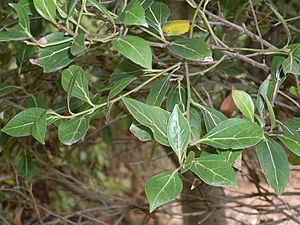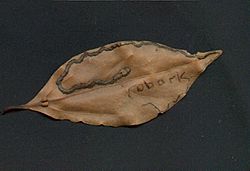Cryptocarya foveolata facts for kids
Quick facts for kids Cryptocarya foveolata |
|
|---|---|
 |
|
| Cryptocarya foveolata - leaves from Mount Royal, Australia | |
| Scientific classification | |
| Genus: |
Cryptocarya
|
| Species: |
foveolata
|
The mountain walnut (Cryptocarya foveolata) is a special rainforest tree. It grows high up in the mountains of eastern Australia. Even though it's called a "walnut," it's actually part of the laurel family, like the bay laurel used in cooking!
You can often spot its fallen leaves. Look for two small bumps, or "glands," near the bottom of the leaf. The leaves are also compact and have clear veins.
Most trees in the Cryptocarya group prefer warm, tropical places. But the mountain walnut is different! It's unusual because it grows in cooler areas. These places can get frost and even snow sometimes. It's also a very tall tree for its type.
Contents
Where Does the Mountain Walnut Grow?
Cryptocarya foveolata grows in rainforests where the soil is rich and healthy. You'll usually find it above 600 metres (about 2,000 feet) above sea level. It often grows near the Antarctic beech, another cool rainforest tree.
This tree's natural home stretches from Mount Royal in the Barrington Tops area. It goes all the way up to the McPherson Range, which is on the border between Queensland and New South Wales.
What Does the Mountain Walnut Look Like?
The mountain walnut can be a small tree or a very large one. It can grow up to 45 metres (about 148 feet) tall. Its trunk can be as wide as 120 cm (about 4 feet) across! The bark is brown and mostly smooth. It often has lines of small bumps running up the trunk. The bottom of the tree doesn't have big, wide roots sticking out.
Leaves and Flowers
The leaves grow in an alternating pattern along the branch. They are shaped like an oval or an ellipse, with a pointed tip. You can easily see three main veins on the leaf. The middle vein is raised on both the top and bottom of the leaf.
Near the base of the leaf, there are one or two pairs of hollow glands. These are called foveolae. They are found on each side of the main vein. The leaves are usually 4 to 7 cm (about 1.5 to 2.7 inches) long.
Small, creamy-white flowers grow in clusters called panicles. They appear from December to February.
Fruit and Seeds
The fruit of the mountain walnut ripens from October to January. It's a fleshy, black drupe, which is a fruit with a hard pit inside, like a cherry. The fruit is about 12 to 15 mm (about half an inch) wide. Inside, there's a single seed, which is about 10 mm (0.4 inches) across.
For the seeds to grow well, it's best to remove the fleshy outer part (called the aril). About one-third of the seeds will sprout and grow into new trees.

See also
 In Spanish: Cryptocarya foveolata para niños
In Spanish: Cryptocarya foveolata para niños

